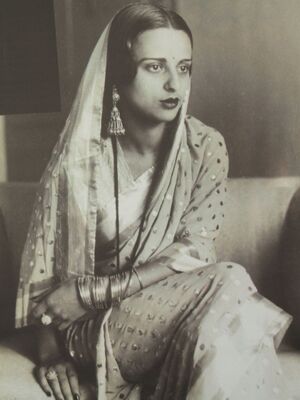Amrita Shergill

Amrita Shergill or Amrita Sher-Gil (अमृता शेरगिल) (30 January 1913 – 5 December 1941) was an eminent Indian painter born to a Punjabi Sikh father and a Hungarian mother.
Princess Amrita Sher-Gill of Majithia

Princess Amrita Sher-Gill of Majithia (30 January 1913 – 5 December 1941) was an eminent Hungarian-Indian painter. She has been called "one of the greatest avant-garde artists of the early 20th century" and a "pioneer" in modern Indian art. Rajkumari Amrita Sher-Gill was born on 30 January 1913 in Hungary, a Shergill Jat aristocrat Raja Umrao Singh of Majithia (Shergill) and Marie Antoniette Gottesmann, a Hungarian who came from an affluent bourgeois family.
Her paintings are displayed at the National Gallery of Modern Art, New Delhi. One of the most prominent roads of Delhi , Amrita Shergil Marg, near Khan Market and Lodhi Garden is named after her.
Estate:- Majitha
Dynasty:- Sher-Gill Jats.
Early life
Amrita Sher-Gil was born in Budapest, Hungary [1] to Umrao Singh Sher-Gil Majithia, a Sikh aristocrat and a scholar in Sanskrit and Persian, and Marie Antoniette Gottesmann, a Jewish opera singer from Hungary. Her mother came to India as a companion of Princess Bamba Sutherland.[2] [3] Sher-Gil was the elder of two daughters born. Her younger sister was Indira Sundaram (née Sher-Gil), mother of the contemporary artist Vivan Sundaram. She spent most of early childhood in Budapest. She was the niece of Indologist Ervin Baktay. He guided her by critiquing her work and gave her an academic foundation to grow on. He also instructed her to use servants as models. The memories of these models would eventually lead to her return to India.[4]
In 1921 her family moved to Summer Hill, Shimla in India, and soon began learning piano and violin, and by age in nine she along with her younger sister Indira were giving concerts and acting in plays at Shimla's Gaiety Theatre at Mall Road, Shimla.[5] Though she was already painting since the age of five she formally started learning painting at age eight. Three Girls, 1935, now at the National Gallery of Modern Art in New Delhi.
In 1923, Marie came to know an Italian sculptor, who was living at Shimla at the time and in 1924 when he returned to Italy, she too moved to Italy along with Amrita and got her enrolled at Santa Annunziata, an art school at Florence. Though Amrita didn't stay at this school for long, and returned to India in 1924, it was here that she was exposed to works of Italian masters.[6]
At sixteen, Sher-Gil sailed to Europe with her mother to train as a painter at Paris, first at the Grande Chaumiere under Pierre Vaillant and later at École des Beaux-Arts (1930–34), she drew inspiration from European painters such as Paul Cézanne and Paul Gauguin, while coming under the influence of her teacher Lucien Simon and the company of artist friends and lovers like Boris Tazlitsky. Her early paintings display a significant influence of the Western modes of painting, especially as practiced in the Bohemian circles of Paris in the early 1930s. In 1932, she made her first important work, Young Girls, which led to her election as an Associate of the Grand Salon in Paris in 1933, making her the youngest ever and the only Asian to have received this recognition.
In 1934, while in Europe she "began to be haunted by an intense longing to return to India feeling in some strange way that there lay my destiny as a painter", as she later wrote about her return to India the same year.
Came to Saraya
Sher-Gil married her Hungarian first cousin, Dr. Victor Egan in 1938 and moved with him to India to stay at her paternal family's home in Saraya in Gorakhpur, Uttar Pradesh.
It was during her stay at Saraya that she painted the Village Scene, In the Ladies' Enclosure and Siesta all of which portray the leisurely rhythms of life in rural India. Siesta and In the Ladies' Enclosure reflect her experimentation with the miniature school of painting while Village Scene reflects influences of the Pahari school of painting.
In September 1941, Victor and Amrita moved to Lahore, then in undivided India and a major cultural and artistic centre.
Death
In 1941, just days before the opening of her first major solo show in Lahore, she became seriously ill and slipped into a coma, and later died around midnight on 6 December 1941. Amrita was cremated on 7 December 1941 at Lahore.
External links
Gallery
-
Raja Umrao Singh of Majithia (1870-1954), the father of the famous colourful and innovative painter Amrita Sher-Gil. He was was born at Majitha, a village in Amritsar district into a Sher Gill Jat family. He was the eldest son of Raja Surat Singh Majithia.
References
- ↑ "Budapest Diary". Outlook. 20 September 2010.
- ↑ Kang, Kanwarjit Singh (20 September 2009). "The Princess who died unknown". The Sunday Tribune.
- ↑ Khushwant Singh (27 March 2006).
- ↑ On Amrita Sher-Gil: Claiming a Radiant Legacy By Nilima Sheikh
- ↑ Amrita Shergill at sikh-heritage. Sikh-heritage.co.uk (30 January 1913).
- ↑ Amrita Shergill Biography at. Iloveindia.com (6 December 1941).
Back to Famous Jat Women


